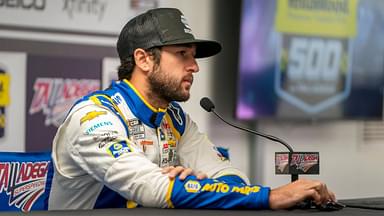As much as fans count down the days to superspeedway showdowns at venues like Daytona, Talladega, and Atlanta for the sheer adrenaline rush, their excitement has become more selective. These days, many viewers tune in primarily for the second and final stages, as the opening laps at superspeedways are often nothing more than a fuel-saving parade.
Advertisement
With the advent of the Next Gen era in 2022, the very DNA of superspeedway racing has changed course, trading pedal-to-the-metal intensity for calculated restraint and survival mode. Built with the intent to cut costs and level the playing field, the Next Gen cars have ushered in a new norm where conserving fuel and laying low until the final laps has become standard operating procedure.
Gone are the days of drafting battles and lead swaps that kept fans on the edge of their seats right from when the green flag is waved. Now, it’s about riding at half-throttle, biding time, and waiting for the field to make mistakes.
This shift in dynamics was highlighted recently by the NASCAR Insights X page left fans more frustrated than impressed. The post read: “At Talladega last Fall: 140 of the 171 green flag laps saw 20+ cars within 1 second of the leader, the most in ANY race on record. Additionally, it saw 44 consecutive laps (L17 – L60), with 20+ cars within 1 second of the leader, the most ever.”
For fans, this only proves the illusion of action in races now defined more by patience than performance.
Many fans were quick to point out that the tight one-second gap between the leader and more than 20 cars wasn’t competitive racing, but rather the byproduct of widespread fuel-saving tactics. Drivers largely refrain from making moves, often running three or even four-wide without fear of triggering wrecks, because no one really wants to take charge.
One fan cut through the facade, remarking, “Just cars driving in circles. Not racing.” Another echoed the frustration, stating, “They were running at half throttle the whole time. It looks pretty but it is not real.”
At Talladega last Fall:
140 of the 171 green flag laps saw 20+ cars within 1 second of the leader, the most in ANY race on record.
Additionally, it saw 44 consecutive laps (L17 – L60), with 20+ cars within 1 second of the leader, the most ever. pic.twitter.com/s412eUx2vt
— NASCAR Insights (@NASCARInsights) April 23, 2025
A third fan didn’t mince words either, adding, “This is just a cool picture to bandaid the problem. The race was terrible. The cars are awful and cannot work the draft. Just a 460 mile fuel saving race until you get in the last fuel window and then still can’t make lines move.”
Others joined the chorus of discontent. “It’s garbage racing, let’s be honest,” wrote one, while another chimed in with, “No passing, just mid-throttle formation laps. I’d take the tandem racing any day over this.”
The issue isn’t confined to just superspeedways. A similar pattern evolved at Michigan last year, where the absence of restrictor plates only amplified the emphasis on fuel conservation over outright performance, once again turning what should have been a battle into a game of mileage and patience.
NASCAR drivers and veterans aren’t fond of fuel-saving
Leading into last fall’s race at Talladega, Ryan Blaney didn’t mince words when sharing his discomfort with the increasingly common fuel-mileage strategies at superspeedways. He acknowledged that while such tactics help stretch pit windows by keeping speeds in the sweet spot, they have turned the racing into a calculated waiting game.
As Blaney pointed out, no one enjoys racing that way. However, in a sport where every edge matters, no team can afford to leave strategy on the table.
Denny Hamlin echoed similar concerns on Actions Detrimental earlier last season, admitting, “I’m so tired of running fuel mileage races where we’re all running half-throttle.” Though he expressed a desire to see change, he admitted his hands are tied. Sometimes the strategy pays off, and sometimes it doesn’t, but the system forces everyone to play the same hand.
On The Dale Jr. Download, Dale Earnhardt Jr. raised even sharper concerns about the direction of superspeedway racing. He argued that the current car package, originally introduced to mitigate wrecks like the 2018 Daytona crash, has swung the pendulum too far in the opposite direction.
According to him, tracks like Daytona and Talladega now reward fuel conservation over competition, turning what used to be edge-of-your-seat racing into single-file cruising.
Ricky Stenhouse Jr.’s crew chief Mike Kelly, however, struck a different chord. From his perspective, there’s no real issue, just smarter teams making the most of the rulebook. He acknowledged that while the racing might look less aggressive, crew chiefs are simply sharpening their tools, using strategy to outwit the competition.
Considering their Talladega win last October executed the very strategy in question, it’s hardly a surprise that he sees no reason to change it now.






